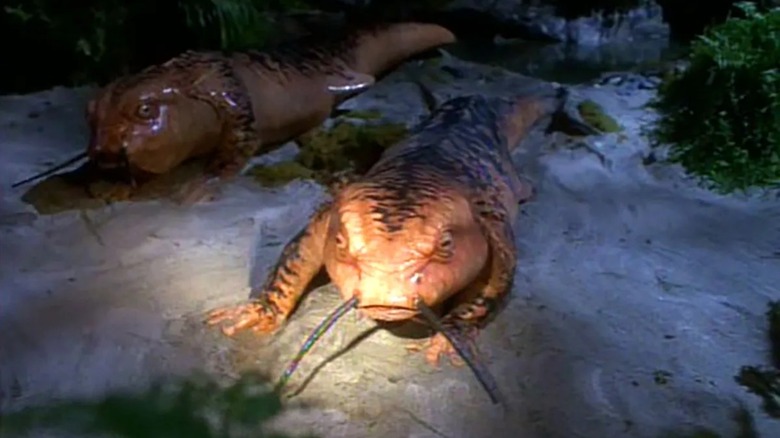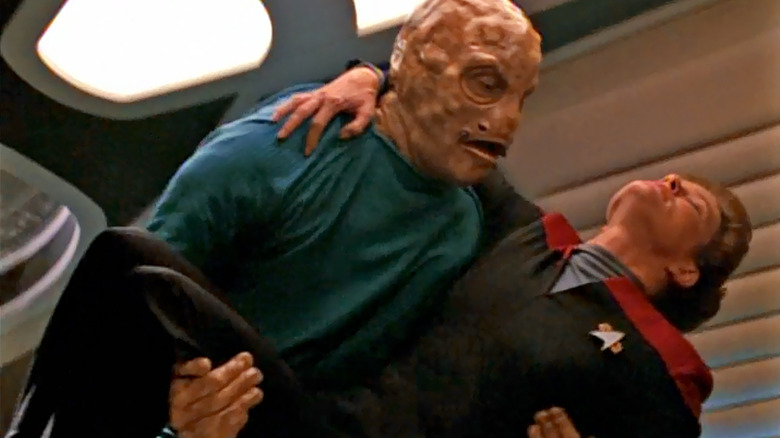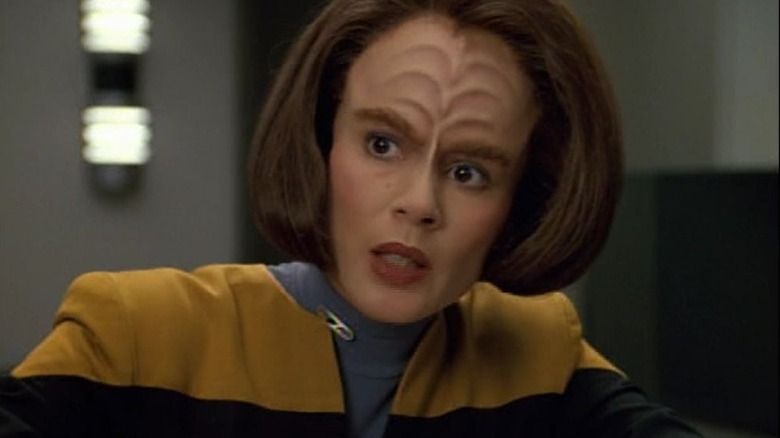How One Of Star Trek: Voyager's Weirdest Concepts Wound Up In Lower Decks
In the first episode of the fourth season of "Star Trek: Lower Decks," called "Twovix," the crew of the U.S.S. Cerritos has been given a delicate mission. It seems that the U.S.S. Voyager, having returned from the Delta Quadrant only a few years prior, has now been converted into a flying museum commemorating that ship's many adventures. The Voyager must be accompanied to Earth, where it will be opened to the public, and the Cerritos has to oversee the transport. The old Intrepid-class starship contains mannequins wearing mission-worn uniforms and touts periodic diorama-bound exhibits explaining some of the Voyager's more outlandish shenanigans. "It's Voyager," one of the Cerritos crew members fliply points out, "S*** got crazy."
One of the stranger exhibits features a pair of outsize, orange animatronic salamanders that will be instantly recognizable to "Star Trek: Voyager" fans. In the episode "Threshold" (January 29, 1996), the Voyager crew discovers a way to break the Warp 10 barrier and achieve infinite velocity. This would allow them to pass through every point in the universe simultaneously, and would certainly help the lost ship return home to Earth. However, when Tom Paris (Robert Duncan McNeill) tests the technology on a modified shuttlecraft, he returns changed. His body begins mutating like in David Cronenberg's "The Fly." It seems that breaking the Warp 10 barrier caused Tom to hyper-evolve.
After he has partially transformed into an amphibian, Tom kidnaps Captain Janeway (Kate Mulgrew) and also takes her on a Warp 10 flight. The pair are later discovered on a nearby planet, having fully transformed into four-foot salamanders ... and having mated.
The director of "Twovix," Barry Kelly, recently discussed the references to "Threshold" with MovieWeb. He noted that turning the old episode's odd story into a new in-universe animatronic was a challenge.
The challenges of an animatronic salamander
Kelly felt that Tom Paris and Captain Janeway did not evolve into salamanders in "Threshold" but into reptiles. Regardless, it's a strange story and one that is made all the stranger by the fact that Tom and the Captain mated while in their animal form. When the two officers are rescued by their fellow Voyager crewmates and transformed back into humans, Janeway notes that she sometimes envisioned having children ... though not quite under those circumstances.
"Threshold" was weird enough that Kelly required references to it for "Twovix." He said:
"There were some challenges in ['Twovix']. In 'Star Trek: Voyager,' there was an episode where Tom Paris and Capt. Janeway hyper-evolve into lizards and it's just such a weird concept. And we couldn't have a 'Voyager' episode without it. So, we wanted to make something like a museum exhibit that has these lizards as animatronics on display. But we wanted it to look like a specific animatronic you see at Disney or something."
This, of course, is a sci-fi anachronism. In a future full of elaborate hologram technology and life-like intelligent machine species, is a quaint, Disneyland-style animatronic really going be to built? Probably not, but it provides for a cute gag and an amusing reference. The future anachronism can be forgiven. Kelly noted that the salamanders had to look artificial, so he made them look clunky, low-tech, and a little, in his words, "dumb":
"We had to give it joints and make it kind of walk dumb. We tried to make it like a dumb robot, and then it gets hacked. So, we have this threat, [then] these holograms that are classic, and then 'Voyager' episode characters come in."
Clarity is key
Of course, clarity was key for Kelly. Unlike in an explanatory article on /Film, he didn't have the space or the time to explain the references or where the salamanders came from. The gag plays better if a viewer is familiar with "Star Trek: Voyager," but Kelly was more concerned with viewers who weren't. As such, when an obscure returning character appears on "Lower Decks," he needed to include quick visual shorthand for who they were and if they posed a threat or not. The "Voyager" references were particularly hard to deal with as "Voyager" was a wild show, complete with 1930s-style holographic villains, sexy Irish boyfriends from the 19th century, and hyper-evolved salamanders. Kelly said:
"For us, it's always about nailing those weird concepts and making sure that when the audience is watching it, they understand what they're looking at. That was one of the challenges, but it was a fun one. I can't always say, like, I need to make an evil robot lizard in every TV show I work on."
One might hope that some of the oddball ideas in "Twovix" might translate to younger viewers wanting to go back and watch "Voyager." Of the extant "Star Trek" shows, "Voyager" had some of the stranger and more ambitious stories. It wasn't always a great show — "Threshold" is often cited as one of the more outlandish episodes of the series — but one can admire its ambition and temerity. When it comes to "Voyager" references on "Lower Decks," the show's writers all must face a similar challenge to Kelly's. Namely: How do we make these weird-ass stories feel natural in the world of "Star Trek?"


